Two or three years ago I discovered Kengné Téguia’s work, even before I knew him; and what a surprise it was to meet him, attending one of my courses given at the ENSAPC. Obviously he was not comfortable in this school, or more precisely the school could no longer bring him much in terms of the questions he was exploring in his performances and videos.
What immediately struck me was the incredible insistence, perseverance and continuity in deciphering an extremely complex territory that involved issues of race, gender and disability.
I don’t remember if I perceived from the beginning that the videos produced invested questions relating to sound, dance and the body, obeying a requirement of visibility that did not require the identity filter. It seemed more complex. What is at stake is multiple, and does not assert itself through the usual prisms of perceptions/investigations specific to racial, gender or disability issues. Everything is intertwined, and it is precisely this mixing that makes the specificity of Kengné Téguia’s work unique, and designates him as an intruder.
His work is an intrusion into the field of video art, and the performance that arises with the consequent disruption of our apprehension, of what hearing and listening imply, designate, presuppose and therefore regulate, oust, etc.
Kengné was born 80% deaf. He benefited from hearing aids from an early age1 and, under pressure from the medical profession, followed a classical course focusing on oral communication for better integration into an « ableist « 2 society. Thanks to the prostheses, he had « access to hearing with the remaining 20%… and was able to follow a classical school curriculum that encourages oral expression, i.e. surrounded by hearing people3 « . He thus excluded himself (indirectly, because he was not the one who made the initial decision) or more precisely moved away from the deaf community to enter the world of normality4, posing as someone else, assimilating self-denial, a denial that is not remembering what Franz Fanon was talking about these blacks who do everything to be someone else, that is, a white man5. By conforming to the world of the hearing people, he puts himself on the margins of a community and consequently of a zone of sharing on which to rely, of a history (that of the deaf) which is never told, nor even envisaged, here in France. Let us remember that sign language (LSF) was not recognized and taught until 19966.
The act of masking, and what it implies as a strategy of compensation, diversion and appropriation, is all the more interesting as the artist will work with two media to which he could not have access: music and dance. The possibility of singing, and therefore of hearing oneself, but also of hearing oneself sing again to (re)produce a melody, or a rhythm, is a powerful element in Kengné Téguia’s approach. Singing and talking is like getting along more or less without even paying attention. These two operations are problematic for Kengné. Mimicking the choreography that accompanies the singing is yet another thing, because it is then the question of balance, linked to the inner ear as the place of its production that comes into play.
His approach to music is based on the perception of sounds, noises, which have shaped his imagination through the lyrics of the songs. An imaginary that led him, after viewing clips, to appropriate certain « hits » and to propose new versions of them, unheard of in every sense of the word. The transition from noise to melody was a long learning process that finally allowed him to accompany his video clips. But this is not where his artistic work really takes shape. We have to wait for the onset of the total deafness that strikes him at 25 years old. He is then offered « bionic » implants which consist of two parts, one connected to the auditory nerve, and the other, external, which picks up sounds. Implants that give him much better hearing when the device is plugged in77. It is at this moment that Kengné Téguia abandons computer science to gradually devote himself to an artistic practice that will be practiced mainly in the fields of video and performance through numerous experiments.
 His video work began in the mid-2010s, and then became one of the most challenging of his generation. What strikes us immediately is the extraordinary singularity of his approach, which crosses many modalities of portraiture and self-portraiture, auto-fiction and re-make8 (see Adjani is my possession 2017 https://vimeo.com/169516919)9, but which also borrows from queer iconography, playing/altering afros exotism, all accompanied by a work of sound and image manipulation that plays with software as did Ryan Trecartin10 in a more empirical way at the end of the 90s, using for example all the effects offered by the most common editing software. Kengné Téguia sets up transmission/translation systems that more or less indirectly integrate circuits and devices that allow him to hear. While it is important that it works in the most fluid and discreet way possible in the case of hearing, for the visual field it is different, in that dysfunctions, gaps or delays – in the transmission, in the decoding of visual and/or sound information – mobilize capacities for adaptation, use and/or re-use that create fragile, flickering or erratic audiovisual inscriptions. The persistence, the tenacity of the experience, generates audio-visual pieces that thwart the expectations of the simple karaoke, or the remake that makes character substitution its main object. Kengné’s tapes, when he sings a particular hit (by Celine Dion, Madonna, Janet Jackson or Lauryn Hill), are not only about mimicking the voice, they are more about learning how to utter it than about the accuracy of the tone. In most cases – if we refer to « fair » reproduction – this is inadequate. What matters in each proposal are the gaps, both set up, revealed and (ab)-used, between what is heard and the restitution that is made. But this is also what these same gaps, these delays, trigger and reveal to us as to the proximity of the statement of a voice, in the relationship it maintains as much with the body of the person who emits it as with that of those who hear it. By juxtaposing them in several of his films, Kengné Téguia highlights the inevitable gap that separates the time of execution from that of reception. His films are frequently made from performance recordings (reworked in post-production) that feature live sound transcription devices, both graphic and sound transcriptions. The meaning of the words spoken, although intelligible, is destabilized by an emission that goes from the breath to the scream, through the whispering. The sound emission moves away from the instructions and practices of speech, from its usual field; it signs and marks deviations, indicates possible convergences between the graphic representation, the code and the sound. For its part, the rhythm proceeds from a muted beat, almost from a percussive ritornello that carries the song by placing it in an elsewhere that makes the word waver towards the musical, without falling into the production of a melody. We are at the threshold of melody, in a space that gives the song the hesitation of sound production; a little withdrawn, suspended from the enunciation that does not come where one would expect it to appear. You have the impression that you are sometimes in the head of a person who repeats a sentence over and over again, or that you are listening to someone who does not follow the same patterns as us regarding the production and enunciation of the language. We are, in fact, placed in a situation of strangeness where the melody is dissociated and the signifier that it shouts. The acoustic signifier suddenly detaches itself to become other. It is a translation work that, beyond the reuse of words in another language, engages in a hand-to-hand combat that makes sound a transcription and a partial manifestation of the body. Thus, the work of speech and its restitution summons the body, and consequently calls for self- portraits. The latter, although prolonging this tradition of self-portraiture in painting, photography or video, take on a completely different dimension in that they stage devices aimed at altering and transmitting sound to the image, and into the image. Each film explores one or more possible relationships between sound and image where the duplicity of synchronism is undermined.
His video work began in the mid-2010s, and then became one of the most challenging of his generation. What strikes us immediately is the extraordinary singularity of his approach, which crosses many modalities of portraiture and self-portraiture, auto-fiction and re-make8 (see Adjani is my possession 2017 https://vimeo.com/169516919)9, but which also borrows from queer iconography, playing/altering afros exotism, all accompanied by a work of sound and image manipulation that plays with software as did Ryan Trecartin10 in a more empirical way at the end of the 90s, using for example all the effects offered by the most common editing software. Kengné Téguia sets up transmission/translation systems that more or less indirectly integrate circuits and devices that allow him to hear. While it is important that it works in the most fluid and discreet way possible in the case of hearing, for the visual field it is different, in that dysfunctions, gaps or delays – in the transmission, in the decoding of visual and/or sound information – mobilize capacities for adaptation, use and/or re-use that create fragile, flickering or erratic audiovisual inscriptions. The persistence, the tenacity of the experience, generates audio-visual pieces that thwart the expectations of the simple karaoke, or the remake that makes character substitution its main object. Kengné’s tapes, when he sings a particular hit (by Celine Dion, Madonna, Janet Jackson or Lauryn Hill), are not only about mimicking the voice, they are more about learning how to utter it than about the accuracy of the tone. In most cases – if we refer to « fair » reproduction – this is inadequate. What matters in each proposal are the gaps, both set up, revealed and (ab)-used, between what is heard and the restitution that is made. But this is also what these same gaps, these delays, trigger and reveal to us as to the proximity of the statement of a voice, in the relationship it maintains as much with the body of the person who emits it as with that of those who hear it. By juxtaposing them in several of his films, Kengné Téguia highlights the inevitable gap that separates the time of execution from that of reception. His films are frequently made from performance recordings (reworked in post-production) that feature live sound transcription devices, both graphic and sound transcriptions. The meaning of the words spoken, although intelligible, is destabilized by an emission that goes from the breath to the scream, through the whispering. The sound emission moves away from the instructions and practices of speech, from its usual field; it signs and marks deviations, indicates possible convergences between the graphic representation, the code and the sound. For its part, the rhythm proceeds from a muted beat, almost from a percussive ritornello that carries the song by placing it in an elsewhere that makes the word waver towards the musical, without falling into the production of a melody. We are at the threshold of melody, in a space that gives the song the hesitation of sound production; a little withdrawn, suspended from the enunciation that does not come where one would expect it to appear. You have the impression that you are sometimes in the head of a person who repeats a sentence over and over again, or that you are listening to someone who does not follow the same patterns as us regarding the production and enunciation of the language. We are, in fact, placed in a situation of strangeness where the melody is dissociated and the signifier that it shouts. The acoustic signifier suddenly detaches itself to become other. It is a translation work that, beyond the reuse of words in another language, engages in a hand-to-hand combat that makes sound a transcription and a partial manifestation of the body. Thus, the work of speech and its restitution summons the body, and consequently calls for self- portraits. The latter, although prolonging this tradition of self-portraiture in painting, photography or video, take on a completely different dimension in that they stage devices aimed at altering and transmitting sound to the image, and into the image. Each film explores one or more possible relationships between sound and image where the duplicity of synchronism is undermined.
A loop repeats the same scrolled pattern. It can be an incantation – as in SatisfiedGone (2017)11 https://vimeo.com/198606800-, a text sung by Kengné, but also melodies, shouts accompanying a multitude of images, portraits of the artist as a singer, « pushed » by various visual treatments or interruptions of the flow, interspersed with fragments, intertitles of the same decapitated, permuted statement, burst on the surface of the image. Kengné plays with the motifs of the self-portrait, and breaks the frame with a strong pixellisation, unframing, poor and saturated images, the rupture of sound and visual flows.
 We are constantly referred to the portrait of an artist dispossessed of himself, through a collection, a proliferation of self-portraits that explore this « imaginary close to a ritual where this despair of becoming these others would be solved at the end of incantations, spells« . We are witnessing an experiment that calls for many interpretations and plays with a multitude of codes from racial, colonial or gender filters that shape our dispositions to see and hear.
We are constantly referred to the portrait of an artist dispossessed of himself, through a collection, a proliferation of self-portraits that explore this « imaginary close to a ritual where this despair of becoming these others would be solved at the end of incantations, spells« . We are witnessing an experiment that calls for many interpretations and plays with a multitude of codes from racial, colonial or gender filters that shape our dispositions to see and hear.
Kengné plays with the proliferation of archetypes that haunt our perceptual habitus. He works simultaneously several registers: narcissism [Narcisse 2 (2015), or Got’til it’s gone (2015)], voyeurism, exoticism [Zombie (2015)], disability [Are you Ok? (2016)], diversion [Blanche Neige is my Bitch (2016)], etc.
Often, several sound strata stage the voice, to which is added an instrumental stratum of a percussive type. The distribution of the voices is reminiscent on the one hand of the back-up singers repeating a melody, and on the other hand of the soloist who takes up a « tube » whose air is not recognized, but whose lyrics provide clues as to the possible source, for partial or total recognition by the audience. In this case the initial air is superimposed (in our head) on the one heard, proposed by Kengné. Elsewhere, as in Erotica Romance (2015) (https://vimeo.com/136408879) – a cover of Madonna’s Erotica12 – the text uttered, not quite sung, is transcribed into the image. Kengné’s re- appropriation of Madonna’s song is not lacking in irony insofar as, as Bell Hooks wisely noted, Madonna is a prototype of the white woman appropriating black culture13. The use of black and white, transparencies by superposition, the shaking of the image as if it were both the result of a quivering water or a deforming magnetic wave, all this is not without evoking the interventions of Nam June Paik14 or Wolf Vostell15 with magnets in their first video experiments. Kengné Téguia uses all the possibilities that his mastery of software and bugs allows him to work in several image registers. He judiciously explores the range from the « policed » image, promoted by the entertainment industry and most of the art market, to that of hackers and amateurs who work with glitch, bugs and poor image. He finds these ways of approaching the moving image – based on its uses linked to the Internet – which offer treatment palettes ranging from overload to impoverishment, and which many plastic artists have integrated into their practices. If Ryan Trecartin is one of those who has explored these possibilities the most, by making his films into collections of effect catalogues that participate in the stories set up in these tapes, it is however Hito Steryel16 who theorized these uses by focusing more particularly on the aesthetics of poor images. These questions relating to the poor image are predominant because they point in the direction of what is available according to criteria related to economic, cultural and racial domination. So it is no coincidence that Kengné Téguia appropriates these different worlds, these different aesthetics, with a gesture that not only inscribes his belonging to the world of whites – I master all this as well as you – but also to the queer and Afro world. His approach flourishes in these uses, evoking what intersectionality17 develops with regard to the plurality of spheres of domination, and which allows him to switch from one field of disability to other fields, without excluding each other, but on the contrary affirming himself, sometimes in the same band, simultaneously or consecutively. Akosua Adoma Owusu’s Intermittent of Delight (2007) presents a similar problem, although approached differently, in which the filmmaker works on the overlap of identity issues with regard to cultural appropriation. It is by articulating these plural identities, by re-articulating them that Kengné Téguia offers in his various videos and performances alternatives to these forms of domination.
 In I can’t deal with it, it’s over (2017), he « addresses the question of identity in the broad sense and questions the trajectory that can exist between language, understanding and reception.18 » This video brings these strata into play by combining voice (or rather voices, because they are worked on in the manner of polyphony), texts, and in the image several lines of narrative (reminiscences of memories, reflections, descriptive snippets) that deviate from what we perceive in the image (sequences of parades of armed and police forces19), subtitles evoking the difficulty of reconciling with the Cameroon experience, the inadequacy between memories and reality of this experience at the time of editing (two years later). In this short band everything is played with mixing and weaving. Temporal mixes evoking the strategies deployed by diarists – and mainly Jonas Mekas, who would be like the archetype – diarists who combine in several films the memory of a place, the confrontation of memory and the moment of its capture as much as the gap perceived during the montage in the perception of this place and what one could feel there, by resorting to the voice and intertitles, which thicken or diverge. This is what Kengné Téguia finds in this short film. As for weaving, it is carried out by the interweaving of sequences that make a comeback, that move forward while coming back, and set up short nodes, overloaded by the number of voices, the simultaneity of texts and images. In this film we find in the background a litany already present in other videos, a rhythmic ritornello acting in the form of incantations and which generated different sensations when it more directly accompanied a self-portrait in Try Again (2015) https://vimeo.com/124112105, or again in Don’t Touch my Hair with this cover of Solange’s « Don’t Touch my Hair »… /… « considered as a kind of hymn to the heritage of African culture, among other things, through frizzy hair and its protection against mini-toxic aggressions against it in Western societies, I explore a kind of imagery where the hair joins this supposed heritage, as well as my deafness – subtitles respecting colour codes corresponding from near and far, to those which serve as a basis for apprehending a sound and/or visual form – and bugs highlighting an aesthetic related to the machine, etc. But in the end, can they understand? »
In I can’t deal with it, it’s over (2017), he « addresses the question of identity in the broad sense and questions the trajectory that can exist between language, understanding and reception.18 » This video brings these strata into play by combining voice (or rather voices, because they are worked on in the manner of polyphony), texts, and in the image several lines of narrative (reminiscences of memories, reflections, descriptive snippets) that deviate from what we perceive in the image (sequences of parades of armed and police forces19), subtitles evoking the difficulty of reconciling with the Cameroon experience, the inadequacy between memories and reality of this experience at the time of editing (two years later). In this short band everything is played with mixing and weaving. Temporal mixes evoking the strategies deployed by diarists – and mainly Jonas Mekas, who would be like the archetype – diarists who combine in several films the memory of a place, the confrontation of memory and the moment of its capture as much as the gap perceived during the montage in the perception of this place and what one could feel there, by resorting to the voice and intertitles, which thicken or diverge. This is what Kengné Téguia finds in this short film. As for weaving, it is carried out by the interweaving of sequences that make a comeback, that move forward while coming back, and set up short nodes, overloaded by the number of voices, the simultaneity of texts and images. In this film we find in the background a litany already present in other videos, a rhythmic ritornello acting in the form of incantations and which generated different sensations when it more directly accompanied a self-portrait in Try Again (2015) https://vimeo.com/124112105, or again in Don’t Touch my Hair with this cover of Solange’s « Don’t Touch my Hair »… /… « considered as a kind of hymn to the heritage of African culture, among other things, through frizzy hair and its protection against mini-toxic aggressions against it in Western societies, I explore a kind of imagery where the hair joins this supposed heritage, as well as my deafness – subtitles respecting colour codes corresponding from near and far, to those which serve as a basis for apprehending a sound and/or visual form – and bugs highlighting an aesthetic related to the machine, etc. But in the end, can they understand? »
Indeed, all of Kengné’s work addresses these questions, confronts us with questions about the areas of understanding we can occupy, to grasp not only his work but also the place that our society offers him, leaves him, gives him, forbids him….. What we hear, what we understand as spectators of these works certainly differs from what Kengné can perceive, and it is the production of these gaps, in this field of sharing that challenges us.
The portrait question refers to the tradition of self-portrait video but more certainly to this use that mobile phones and social networks have had an intensive impact on. The self-portrait, in the age of the Internet, does not have quite the same intentions as those of Anne Charlotte Robertson20 or Vito Acconci in the 1970s or 1980s. Kengné’s portraits do not have the autobiographical dimension that film diary gave them, they are part of a more contemporary dynamic, infused by the uses of the Internet and the circulation of self-images that it induces. Kengné Téguia’s self-portraits have several overlapping dimensions, ranging from homoeroticism to the treatment of race issues. Strange Fruit (2016) refers to Billie Holliday’s song21, and the strange fruits that grows on trees in southern states, but this fruit is also a slang term for homos. This multiplicity of overlaps confers a particular dynamic, and makes the echo of silence resonate.
In other videos, Kengné Téguia works with and from nudity. It then follows a tradition of black portraiture that, since the 1980s, has flourished through the work of Robert Mapplethorpe, or Rotimi Fayi Kayode, with some photos of which we can apprehend a relationship, mainly in Try Again.
The songs performed are not limited to the Afro register alone, although most of them are covers from songs from Janet Jackson, James Brown, Lauryn Hill, Solange, Fela Kuti… Zombiiie https://vimeo.com/131526236 reveals how the appropriation, the diversion, but above all the taking possession of a musical piece that used a copper-battery-guitar ensemble, an ensemble that Kengné reduces to its strict minimum, wink at (but I don’t know if it’s voluntary) the percussion ensembles used by John Cage for certain choreographies by Merce Cunningham. What worked with the codes of a sustained rhythm, as well as the dialogue between the choir and the singer, is considered here according to another economy in which Kengné Téguia supports all the parts at a minimum. In the distance, cries haunt the song, combined with other voices that replace the original instrumentation. Visually we are in a concatenation of different shots of the dancing artist, punctuated by the alternating enchantment of desaturated, granular, solarized sequences, in a soft cotton wool revealing trunk, head, and legs. Their crosses create new bodies – compounds. This use of superimposition, with a view to hybridization, is used by many filmmakers and videographers who thus compare the porosity of the medium and that of the bodies.
It is always a question, not only of staging oneself, but also of making oneself heard. To break through the walls of the confinement that hearing’s world generates for all those who do not share the same perceptual conditions. And this is where Kengné’s approach makes sense, because it simultaneously brings together the contexts whose power of exclusion we refuse to see, whether they are racial, sexual or disability issues. How to deconstruct and rebuild (also) when we do not have the possibility of being outside?22 It is the reign of a multi-imperialism that is here questioned indirectly; with a work that does not denounce but implies, a work that states the end of not receiving affirmed by a society that inscribes rupture, separation, exclusion and isolation among its modes of managing the in- difference.
yann beauvais
translation Kengné Téguia
1 Clarification given by Kengné by mail dated March 4, 2019
2 Ableism : oppression experienced by people living with physical or mental disabilities https://fr.wiktionary.org/wiki/validisme
3 Kengné Téguia: Who are you… Kengné Téguia, from the Black(s) to the future collective, in Culture & enjaillements, Regards noirs, 14 September 2017, blog l’Afro
4 Kengné Téguia statutes in Facebook of December 9, 2018: I am 25 years old…/…/…my ear seems to want to resist, despite this glue, by unfolding itself of all its member, reminding me to what extent it is lost in this new configuration of its space…/…. Caught in the trap by this insidious desire that I would be obliged to hear, obliged to verbalize through this foreign language, orality.
5 Franz Fanon Black skin, white masks, Le seuil 1952. A video (The Struggle 2015) by Kengné uses the introduction of this book by Franz Fanon.
6 It is the 1991 Fabius Law that « promotes the choice of bilingual education for the deaf, the LSF and written/oral French, thus marking the end of the prohibition of the LSF » Wikipedia Sign Language, and it is only in 2005 that the Law for Equal Rights and Opportunities for Participation and Citizenship of Persons with Disabilities was enacted in which LSF is recognized as a language in its own right after a century of prohibition.
7 However, according to translation reports of what deaf people would hear with these implants, there is still a lot of progress to be made in terms of hearing comfort https://www.medisite.fr/a-la-une-video-comment-comment-on-with-an-implant- auditive.628294.2035.html?xtor=EPR-26-628649[Medisite-A-la-Une]-20140530
8 We remember that from the 1990s onwards, when plastic artists took over cinema through exhibition cinema, some of them became interested in the revival and re-making of Hollywood films, in whole or in part. They were reconnecting with something that experimental filmmakers have almost always worked on, either by putting together entertainment films or by parodying them. In the 90s it is the notion of appropriation that became preponderant and manifested itself in the re-make, see for example the Body Doubles made by the artist Brice Dellsperger from 1995 onwards (to date there are 35)
9 Kengné Teguia on this film says Keeping the main idea of Andrzej Zulawski’s film Possession, where Isabelle Adjani is possessed by a monstrous creature, I explore this possession by taking the place of this creature, with the metro scene of the film and my cover of the song, Ex-Factor by Lauryn Hill.
10 See yann beauvais: Ryan Trecartin Internet comme mode de vie, Gruppen n° 9, 2014
11 This is a song by Celine Dion: Pour que tu m’aimes encore
12 Seeing this film I couldn’t help but think of a Mike Hoolboom film that draws self-portraits from or around Madonna’s songs, using a letter addressed to her in Hey Madonna, scrolling through the black and white clip of one of her songs.
13 See bell hooks: in Black Looks race and representation, the chapter Madonna Plantation Mistress or Soul Sister,Page 157: White women « stars » like Madonna, Sandra Bernhard, and many others publicly name their interest in, and appropriation of, black culture as yet another sign of their radical chic. Intimacy with that « nasty » blackness good white girls stay away from is what they seek. To white and other non-black consumers, this gives them a special flavor, an added spice. After all it is a very recent historical phenomenon for any white girl to be able to get some mileage out of flaunting her fascination and envy of blackness. Sound End Press, Boston 1992
14 Nam June Paik: Unknown Exhibition (1963) Magnet TV (1965)
15 Wolf Vostell : 6 TV Dé-collage (installation) and Sun in your head 1963
16 Hito Steryel: see Defence of the Poor Image in The Wretched of the Screen, e-flux Journal, Sternberg Press, 2012
17We remember that Kimberlé Crenshaw was the first to theorize this concept in Cartographies des marges: intersectionality, identity politics and violence against women of colour, who first theorized this concept in 1991.
18 Kengné Téguia : Qui es tu… Kengné Téguia, du collectif Black(s) to the future, in Culture & enjaillements, Regards noirs, 14 septembre 2017
19 These appropriate sequences evoke those used in Cécile Fontaine’s Histoires parallèlles (1990) in which we see
many colonial forces in representation, including French ones on Reunion Island in the 1960s.
20 1949 -2012 Anne Charlotte Robertson is an American filmmaker who has favoured the form of the filmed newspaper, the first-person newspaper, in super 8.
21 The first verse of the song says: Southern trees bear a strange fruit, Blood on the leaves and blood at the root, Black body swinging in the Southern breeze, Strange fruit hanging from the poplar trees, a song in reference to the lynching of blacks, which is another news these days on both sides of the Atlantic.





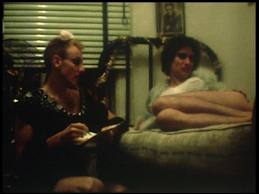 a foto do set está legendada como produção do Spectacular Studios!, datada de 1984. Em algumas fotos, Mark Morrisroe dá um título ao polaróide, mas acrescenta entre parêntesis indicação tal: Ode à Diane Arbus. Todas as marcas parecem criar uma distância, aparentemente, elas traduzem uma apropriação suplementar, a marca de uma subjetividade que se manifesta na produção de um universo fantasmagórico pessoal, a partir da retirada do real, pelo menos (tecnicamente) assistido, quer dizer manipulado. É preciso entender essa manipulação ao pé da letra. A manipulação se exerce duplamente, uma vez no nível do conteúdo, que se trate de retratos ou autorretratos, ou que ela se revele nas formas e técnicas usadas. Enquanto à fotografia, as marcas esboçadas funcionam como mais-valia, elas são os rastros de uma troca epistolar potencial, elas parecem dirigir-se a um destinatário particular (The Boy Next Door, Summer 1983, p 193). Do lado delas, as impressões digitais[8], os arranhões, dobras e manchas insistem sobre o caráter artesanal da produção das fotos, as quais são criadas integralmente por um corpo: o de Mark Morrisroe. (In the Garden of the Water Babies 1983, p 245). Estes rastros bem particulares se veem em vários cineastas que, nos anos 80, decidem controlar todas as etapas e fabricação dos seus filmes, isso quer dizer que eles revelam os filmes eles mesmos, sem recorrer aos laboratórios. Dentre eles, pode-se citar Carolyne Avery, Phil Solomon, Mathias Müller, Jurden Reble. A produção, autonomizando-se, se desenvolve segundo uma estética mais crua, em relação com a cena Punk e Gótica, privilegiando a projeção nos espaços alternativos: clubes, bares. Esses rastros parasitas não são a marca de um know-how, eles respondem a outros critérios que incorporam diferencialmente as modas de produção da imagem. Ela parece confiscar o materialismo dos cineastas estruturais[9], a matéria filme se expande contra um modo de representação burguês, que se acompanha de um conjunto de regras de produção e de apresentação da obra. À imagem lisa e civilizada do cinema narrativo industrial, os cineastas estruturalistas materialistas opõem a brutalidade de suas apropriações e desvios, que colocam em primeiro plano a materialidade do suporte em si, sem concessão nem reinvindicação pessoal. A questão é resistir a um modo dominante, enquanto os cineastas dos anos 80, que se apropriam dessa materialidade, o fazem numa ótica diferente, pois eles se empregam na irrigação subjetiva, nessa matéria fotográfica e cinematográfica. Estamos na presença de uma reterritorialização da matéria cinematográfica, que é reinvestida e se opõe à representação dominante própria, insípida, sem pathos, asseptizada, normatizada.
a foto do set está legendada como produção do Spectacular Studios!, datada de 1984. Em algumas fotos, Mark Morrisroe dá um título ao polaróide, mas acrescenta entre parêntesis indicação tal: Ode à Diane Arbus. Todas as marcas parecem criar uma distância, aparentemente, elas traduzem uma apropriação suplementar, a marca de uma subjetividade que se manifesta na produção de um universo fantasmagórico pessoal, a partir da retirada do real, pelo menos (tecnicamente) assistido, quer dizer manipulado. É preciso entender essa manipulação ao pé da letra. A manipulação se exerce duplamente, uma vez no nível do conteúdo, que se trate de retratos ou autorretratos, ou que ela se revele nas formas e técnicas usadas. Enquanto à fotografia, as marcas esboçadas funcionam como mais-valia, elas são os rastros de uma troca epistolar potencial, elas parecem dirigir-se a um destinatário particular (The Boy Next Door, Summer 1983, p 193). Do lado delas, as impressões digitais[8], os arranhões, dobras e manchas insistem sobre o caráter artesanal da produção das fotos, as quais são criadas integralmente por um corpo: o de Mark Morrisroe. (In the Garden of the Water Babies 1983, p 245). Estes rastros bem particulares se veem em vários cineastas que, nos anos 80, decidem controlar todas as etapas e fabricação dos seus filmes, isso quer dizer que eles revelam os filmes eles mesmos, sem recorrer aos laboratórios. Dentre eles, pode-se citar Carolyne Avery, Phil Solomon, Mathias Müller, Jurden Reble. A produção, autonomizando-se, se desenvolve segundo uma estética mais crua, em relação com a cena Punk e Gótica, privilegiando a projeção nos espaços alternativos: clubes, bares. Esses rastros parasitas não são a marca de um know-how, eles respondem a outros critérios que incorporam diferencialmente as modas de produção da imagem. Ela parece confiscar o materialismo dos cineastas estruturais[9], a matéria filme se expande contra um modo de representação burguês, que se acompanha de um conjunto de regras de produção e de apresentação da obra. À imagem lisa e civilizada do cinema narrativo industrial, os cineastas estruturalistas materialistas opõem a brutalidade de suas apropriações e desvios, que colocam em primeiro plano a materialidade do suporte em si, sem concessão nem reinvindicação pessoal. A questão é resistir a um modo dominante, enquanto os cineastas dos anos 80, que se apropriam dessa materialidade, o fazem numa ótica diferente, pois eles se empregam na irrigação subjetiva, nessa matéria fotográfica e cinematográfica. Estamos na presença de uma reterritorialização da matéria cinematográfica, que é reinvestida e se opõe à representação dominante própria, insípida, sem pathos, asseptizada, normatizada.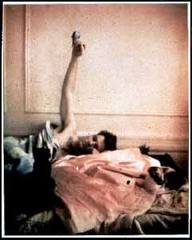
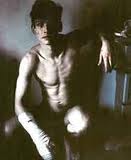

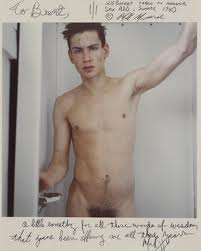


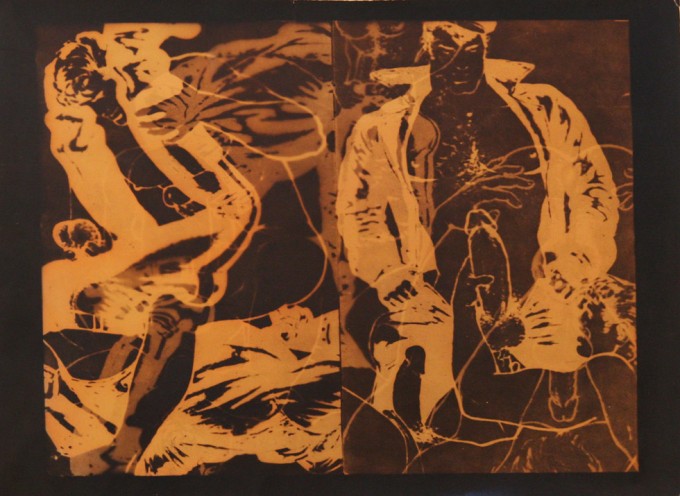
 , Lupe (1965), The Life of Juanita Castro (1965), Camp (1965), The Chelsea Girls (1966), Lonesome Cowboys (1967). Jack Smith e Taylor Mead fizeram desses fracassos aparentes ferramentas muito eficientes de escárnio e de paródia que arruínam nossas expectativas, mergulhando a gente em um universo onde tudo (re)torna-se possível, onde nada é excluído. O personagem de drag nunca pode ser confundido com uma mulher, o que é afirmado é o travestismo. As palavras e os comportamentos dos “atores” parecem espontâneos, embora os filmes tenham sido escritos. Hello from Bertha (1981) é baseado na pequena peça de Tenessee Williams, embora Nymph-O-Maniac (1984) tenha seu roteiro feito a partir de conversas telefónicas sexuais e diálogos de filmes pornôs[14]. Nos filmes de Mark Morrisroe, as repetições sublinham o lado atuado da performance, embora pudéssemos acreditar que é uma gravação direta, tal como Shirley Clarke em Portrait of Jason (1967).
, Lupe (1965), The Life of Juanita Castro (1965), Camp (1965), The Chelsea Girls (1966), Lonesome Cowboys (1967). Jack Smith e Taylor Mead fizeram desses fracassos aparentes ferramentas muito eficientes de escárnio e de paródia que arruínam nossas expectativas, mergulhando a gente em um universo onde tudo (re)torna-se possível, onde nada é excluído. O personagem de drag nunca pode ser confundido com uma mulher, o que é afirmado é o travestismo. As palavras e os comportamentos dos “atores” parecem espontâneos, embora os filmes tenham sido escritos. Hello from Bertha (1981) é baseado na pequena peça de Tenessee Williams, embora Nymph-O-Maniac (1984) tenha seu roteiro feito a partir de conversas telefónicas sexuais e diálogos de filmes pornôs[14]. Nos filmes de Mark Morrisroe, as repetições sublinham o lado atuado da performance, embora pudéssemos acreditar que é uma gravação direta, tal como Shirley Clarke em Portrait of Jason (1967).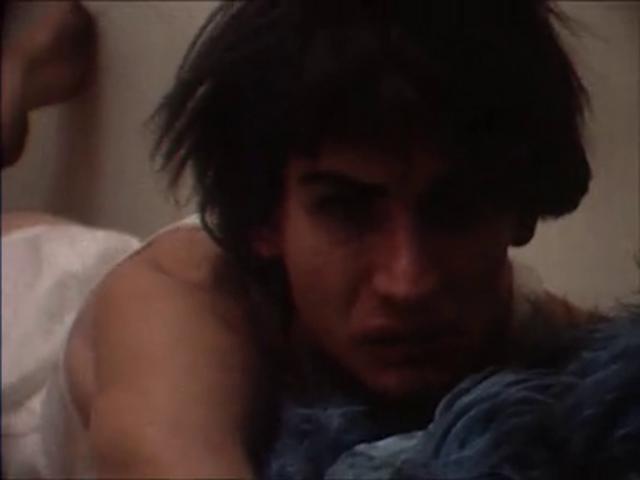 é bem uma adaptação. As relações entre os protagonistas, se limitam a trocas que vão da conivência à repudiação, transitando por várias formas de violência verbal, desconcerto e violência física. Esse mundo é mais sombrio que o de Jonh Waters, talvez porque a trama narrativa sempre está à mercê de um erro do performer. A provocação, o excesso são os motores, sempre mais na decrepitude, na decadência, mas não pode se ver um julgamento moral qualquer, é mais uma escolha estética que se quer trabalhar a partir do que é próximo a si, do que nos motiva, daquilo que nos habita. Assim, vestir-se de mulher, ter um papel fora de si, desviar os códigos dos gêneros sexuais e os ridicularizar por excesso de mímicas, de piscar de olho ou por desconcerto, permite afirmar – além da auto ironia, dos estados de subjetividades, dos brilhos – fragmentos de sujeitos que a “boa educação” desqualifica. Nesse trabalho não é tanto a provocação que importa, como as ofensas sobre os códigos da masculinidade e da feminidade, que são progressivamente laminados. A atribuição dos papeis do gênero é virado de cabeça para baixo, ou pelo menos perturbada[1].
é bem uma adaptação. As relações entre os protagonistas, se limitam a trocas que vão da conivência à repudiação, transitando por várias formas de violência verbal, desconcerto e violência física. Esse mundo é mais sombrio que o de Jonh Waters, talvez porque a trama narrativa sempre está à mercê de um erro do performer. A provocação, o excesso são os motores, sempre mais na decrepitude, na decadência, mas não pode se ver um julgamento moral qualquer, é mais uma escolha estética que se quer trabalhar a partir do que é próximo a si, do que nos motiva, daquilo que nos habita. Assim, vestir-se de mulher, ter um papel fora de si, desviar os códigos dos gêneros sexuais e os ridicularizar por excesso de mímicas, de piscar de olho ou por desconcerto, permite afirmar – além da auto ironia, dos estados de subjetividades, dos brilhos – fragmentos de sujeitos que a “boa educação” desqualifica. Nesse trabalho não é tanto a provocação que importa, como as ofensas sobre os códigos da masculinidade e da feminidade, que são progressivamente laminados. A atribuição dos papeis do gênero é virado de cabeça para baixo, ou pelo menos perturbada[1].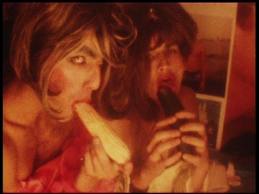
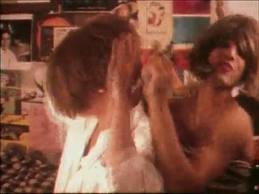 Mark fala da diferença entre um transexual e um travesti: “um transsexual quer ser fisicamente mulher, embora um travesti gosta de vestir roupas femininas, e é o que eu gosto de fazer”. Essa confusão no gênero agrada os protagonistas, fazendo-os atuar com o maior cuidado, mesmo que suas performances não correspondam às expectativas e à performatividade profissional pela qual o ator mergulha no papel que interpreta. Aqui, como em toda atitude campo, é o jogo entre o personagem e o atuante que nos interessa, é a oscilação entre os dois sujeitos que força o nosso interesse. A instabilidade do papel e do sujeito atravessa o filme, a performance manifesta assim possibilidades de subverter os papéis sociais e suas atribuições, segundo as atitudes e comportamentos campo. Como diria Taylor Mead em um dos seus aforismos dos homens apegados aos seus papéis do gênero: “Os homens lindos que não sabem onde os seus talentos residem; escolham a arte, a heterossexualidade, tudo a fim de evitar o que vem naturalmente, ou o que eles teriam obtido de uma cabeça aberta”[2] Uma outra dimensão que aproxima os filmes de Mark Morrisroe a os de Jack Smith e Taylor Mead, John Waters, mas também os de seus contemporâneos David Wojnarowicz e Nick Zedd, é a necessidade deles. As urgências deles testemunham suas energias. Cada filme propõe um espaço fechado, dentro do qual seres se usam e se abusam? Há de se notar que o ambiente de Mark Morrisroe domina: as fotos adornam as paredes, na frente mexendo-se uma fauna que mesmo reduzida, revela um mundo que oscila entre drag e droga. As drags fofocam, falam dos seus desejos, “Eu realmente preciso de uma boa trepada” Esse desejo é mimicado em uma cena onde ele pratica masturbação anal com um pepino, depois em uma cena Jack estupra Mark de drag. Assim, a intimidade é revelada e recomposta segundo as necessidades do filme, a partir do entorno de relações próximas, amantes, amigos… O filme não revela auto retrato como o fazem as fotos, mas propõe incursões nos mundos de Mark Morrisroe. Cada filme desenvolve momentos de subjetividades que questionam a sociedade através da homofobia e da definição dos papéis (It’s all te same you’re queer anyhow!). Nesse sentido, eles prolongam “a celebração de John Waters quanto à natura abjeta da ‘doidice’, comparativamente à sociedade americana”. Para retomar uma análise de Mike Kelley.[3] Os filmes de Mark Morrisroe se dão como sintomas culturais, eles assinam ao mesmo tempo a adesão à uma cultura dada, como ele a denuncia paradoxalmente. Os filmes de Mark Morrisroe frequentemente são apreendidos como “amadores”; eles respondem à mesma dinâmica que as fotografias, assumem o lado supostamente amador, mostrando ao mesmo tempo que o cinema não é um território reservado somente a pessoas patenteadas; nesse sentido eles dividem esse entusiasmo e essa democratização cinematográfica dos movimentos super 8 dos anos 80, antes que ela se amplie com o vídeo; assim como o trabalho dos ativistas da AIDS. Tomar posse do cinema, fazer cinema ou mais especificamente tornar seu o cinema, é conseguir ao mesmo tempo fazer e mostrar as imagens de uma geração, sem mediação externa. É falar em seu nome, não ser dito por outrem. É afirmar sua liberdade sem se satisfazer com aquela que seria proposta para nós. Todo trabalho de Mark Morrisroe participa deste processo de afirmação; mesmo que use a derrisão, a violência ou a destruição, não muda nada. A questão sempre é de afirmar estados, movimentos, pulsões, que não são necessariamente rosas, limpas, ou ronronantes. As pulsões não são civilizadas, elas são cruas e consequentemente mostradas sem artifícios (embora…). A abertura de Nymph-O-Maniac (1984) homenageia John Waters, colocando em cena uma criatura generosa que sem ser brilhante, liga para clientes potenciais, descrevendo suas características físicas e o que ela poderia fazer. Encontramo-nos num mundo ilegal, fraudulento, constituído de prostitutas e lésbicas que moram em um apartamento, cujas paredes estão cobertas de fotos de revistas gays e de capas de LP. A câmera viravolta um pouco à maneira das sex comedies de Morrissey e Warhol; os cortes são bem aparentes quase strobes cut[4], os finais de bobinas super 8 às vezes interrompem a narrativa para melhor relançá-la por meio de um inter título: Later, ou Later than evening… Em um dos planos, no banheiro, percebe-se brevemente no espelho Mark Morrisroe filmando esse dia na vida de uma ninfomaníaca, que recebe à noite dois homens que a empurram antes de amará-la em uma cadeira e a estupram com um cabide metálico, fazendo-a abortar, e depois cortam sua mão direita. O filme acaba com a mulher xingando os dois agressores de bastardos. A violência nas cenas mostradas, principalmente a da mão cortada, antecipa o braço arrancado de David Wojnarowicz em uma das suas narrações[5] de Manhattan Love Suicide (1985) de Richard Ken; filme, porém, mais sanguenolento, pois elas ecoam a violência posta em cena pelo cinema da transgressão. O ambiente geral do filme de Morrisroe evoca mais o clima e o humor negro dos filmes de Jonh Waters; pelo seu lado sórdido e trash, mas ao contrário desse último, a ação se limita a um dia na vida de uma nin. Esse limite temporal não corresponde ao tempo da filmagem como foi o caso com Shirley Clark em Portrait of Jason. Mark Morrisroe não faz nem direct cinema, nem cinema verdade. Ele cria paraísos artificiais, mais ou menos feéricos ou
Mark fala da diferença entre um transexual e um travesti: “um transsexual quer ser fisicamente mulher, embora um travesti gosta de vestir roupas femininas, e é o que eu gosto de fazer”. Essa confusão no gênero agrada os protagonistas, fazendo-os atuar com o maior cuidado, mesmo que suas performances não correspondam às expectativas e à performatividade profissional pela qual o ator mergulha no papel que interpreta. Aqui, como em toda atitude campo, é o jogo entre o personagem e o atuante que nos interessa, é a oscilação entre os dois sujeitos que força o nosso interesse. A instabilidade do papel e do sujeito atravessa o filme, a performance manifesta assim possibilidades de subverter os papéis sociais e suas atribuições, segundo as atitudes e comportamentos campo. Como diria Taylor Mead em um dos seus aforismos dos homens apegados aos seus papéis do gênero: “Os homens lindos que não sabem onde os seus talentos residem; escolham a arte, a heterossexualidade, tudo a fim de evitar o que vem naturalmente, ou o que eles teriam obtido de uma cabeça aberta”[2] Uma outra dimensão que aproxima os filmes de Mark Morrisroe a os de Jack Smith e Taylor Mead, John Waters, mas também os de seus contemporâneos David Wojnarowicz e Nick Zedd, é a necessidade deles. As urgências deles testemunham suas energias. Cada filme propõe um espaço fechado, dentro do qual seres se usam e se abusam? Há de se notar que o ambiente de Mark Morrisroe domina: as fotos adornam as paredes, na frente mexendo-se uma fauna que mesmo reduzida, revela um mundo que oscila entre drag e droga. As drags fofocam, falam dos seus desejos, “Eu realmente preciso de uma boa trepada” Esse desejo é mimicado em uma cena onde ele pratica masturbação anal com um pepino, depois em uma cena Jack estupra Mark de drag. Assim, a intimidade é revelada e recomposta segundo as necessidades do filme, a partir do entorno de relações próximas, amantes, amigos… O filme não revela auto retrato como o fazem as fotos, mas propõe incursões nos mundos de Mark Morrisroe. Cada filme desenvolve momentos de subjetividades que questionam a sociedade através da homofobia e da definição dos papéis (It’s all te same you’re queer anyhow!). Nesse sentido, eles prolongam “a celebração de John Waters quanto à natura abjeta da ‘doidice’, comparativamente à sociedade americana”. Para retomar uma análise de Mike Kelley.[3] Os filmes de Mark Morrisroe se dão como sintomas culturais, eles assinam ao mesmo tempo a adesão à uma cultura dada, como ele a denuncia paradoxalmente. Os filmes de Mark Morrisroe frequentemente são apreendidos como “amadores”; eles respondem à mesma dinâmica que as fotografias, assumem o lado supostamente amador, mostrando ao mesmo tempo que o cinema não é um território reservado somente a pessoas patenteadas; nesse sentido eles dividem esse entusiasmo e essa democratização cinematográfica dos movimentos super 8 dos anos 80, antes que ela se amplie com o vídeo; assim como o trabalho dos ativistas da AIDS. Tomar posse do cinema, fazer cinema ou mais especificamente tornar seu o cinema, é conseguir ao mesmo tempo fazer e mostrar as imagens de uma geração, sem mediação externa. É falar em seu nome, não ser dito por outrem. É afirmar sua liberdade sem se satisfazer com aquela que seria proposta para nós. Todo trabalho de Mark Morrisroe participa deste processo de afirmação; mesmo que use a derrisão, a violência ou a destruição, não muda nada. A questão sempre é de afirmar estados, movimentos, pulsões, que não são necessariamente rosas, limpas, ou ronronantes. As pulsões não são civilizadas, elas são cruas e consequentemente mostradas sem artifícios (embora…). A abertura de Nymph-O-Maniac (1984) homenageia John Waters, colocando em cena uma criatura generosa que sem ser brilhante, liga para clientes potenciais, descrevendo suas características físicas e o que ela poderia fazer. Encontramo-nos num mundo ilegal, fraudulento, constituído de prostitutas e lésbicas que moram em um apartamento, cujas paredes estão cobertas de fotos de revistas gays e de capas de LP. A câmera viravolta um pouco à maneira das sex comedies de Morrissey e Warhol; os cortes são bem aparentes quase strobes cut[4], os finais de bobinas super 8 às vezes interrompem a narrativa para melhor relançá-la por meio de um inter título: Later, ou Later than evening… Em um dos planos, no banheiro, percebe-se brevemente no espelho Mark Morrisroe filmando esse dia na vida de uma ninfomaníaca, que recebe à noite dois homens que a empurram antes de amará-la em uma cadeira e a estupram com um cabide metálico, fazendo-a abortar, e depois cortam sua mão direita. O filme acaba com a mulher xingando os dois agressores de bastardos. A violência nas cenas mostradas, principalmente a da mão cortada, antecipa o braço arrancado de David Wojnarowicz em uma das suas narrações[5] de Manhattan Love Suicide (1985) de Richard Ken; filme, porém, mais sanguenolento, pois elas ecoam a violência posta em cena pelo cinema da transgressão. O ambiente geral do filme de Morrisroe evoca mais o clima e o humor negro dos filmes de Jonh Waters; pelo seu lado sórdido e trash, mas ao contrário desse último, a ação se limita a um dia na vida de uma nin. Esse limite temporal não corresponde ao tempo da filmagem como foi o caso com Shirley Clark em Portrait of Jason. Mark Morrisroe não faz nem direct cinema, nem cinema verdade. Ele cria paraísos artificiais, mais ou menos feéricos ou


























